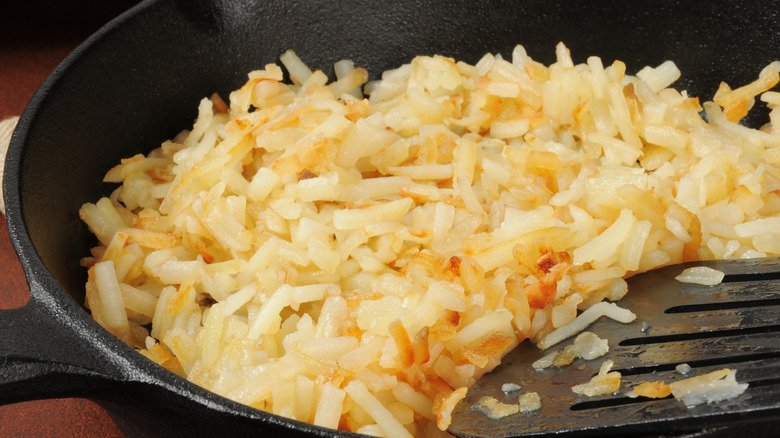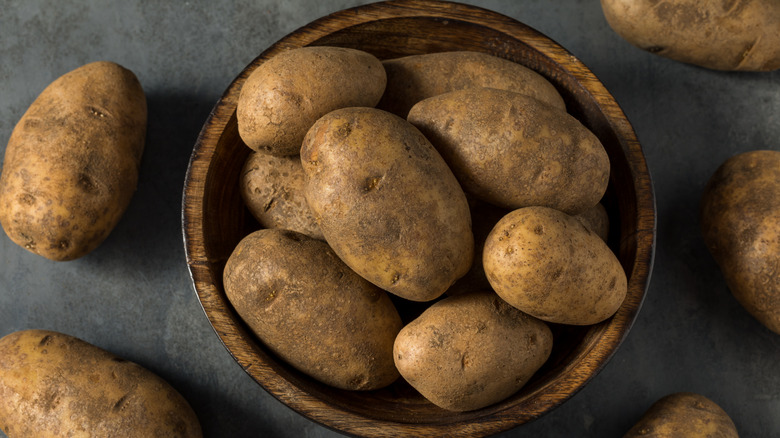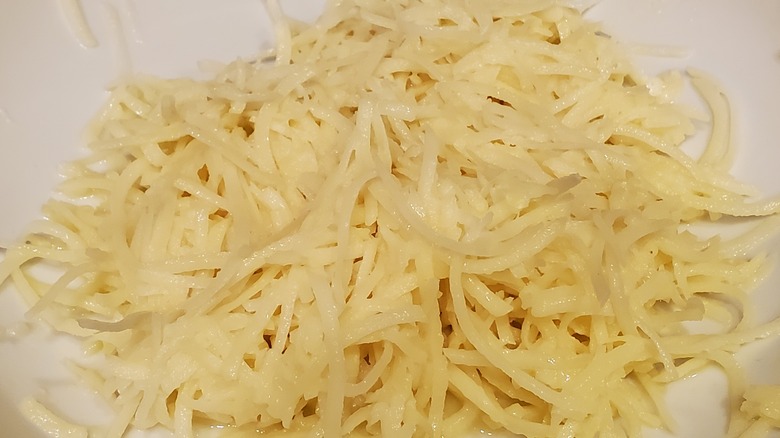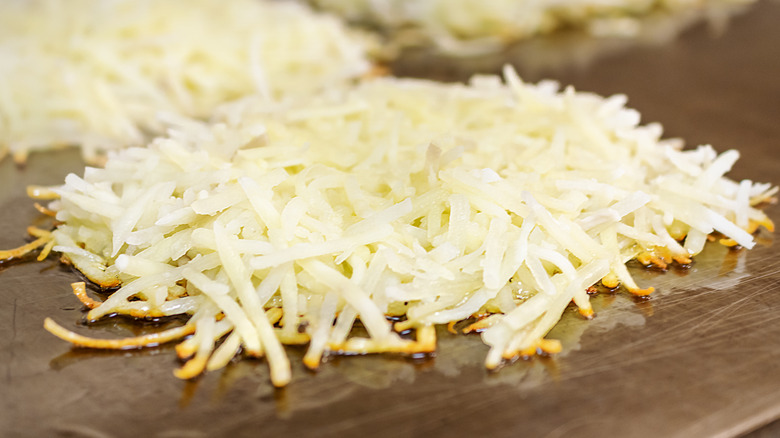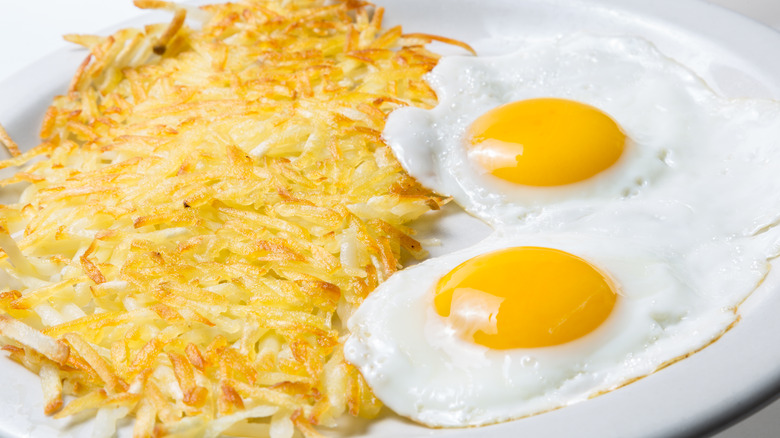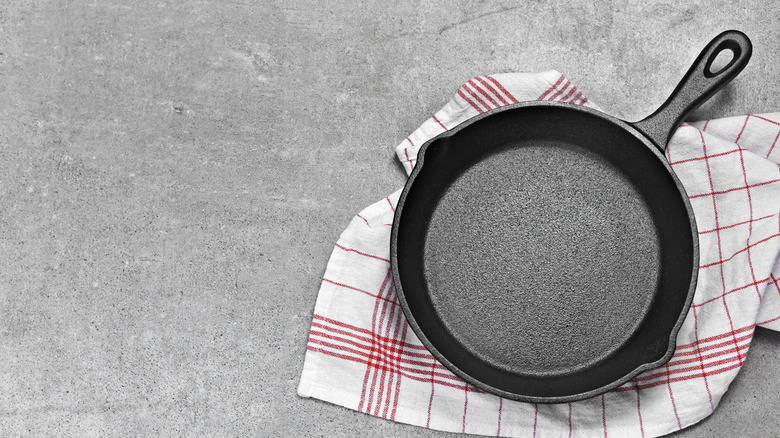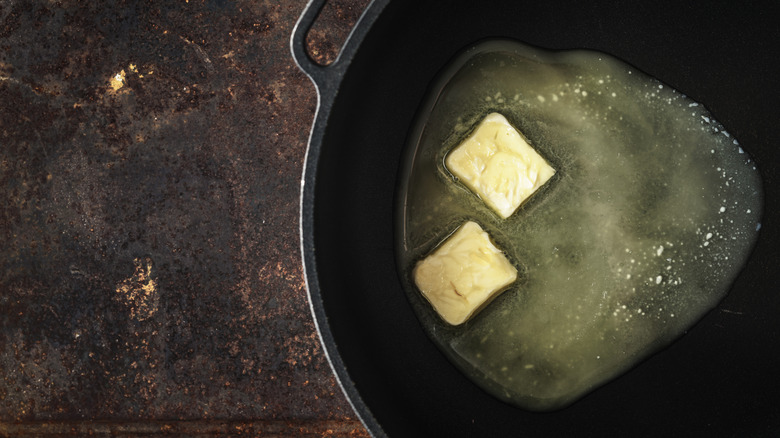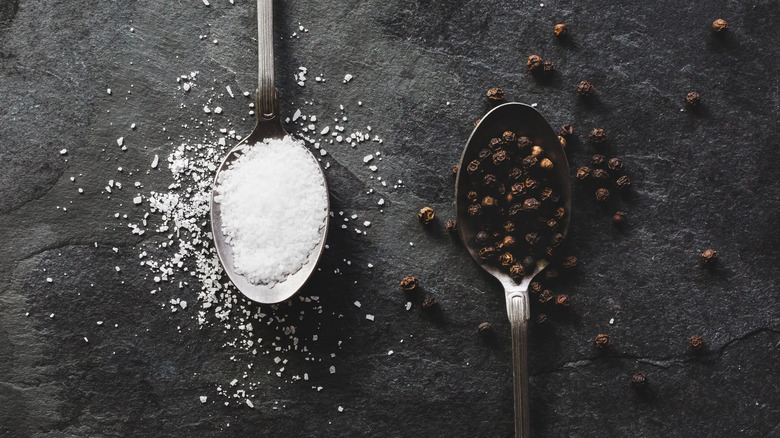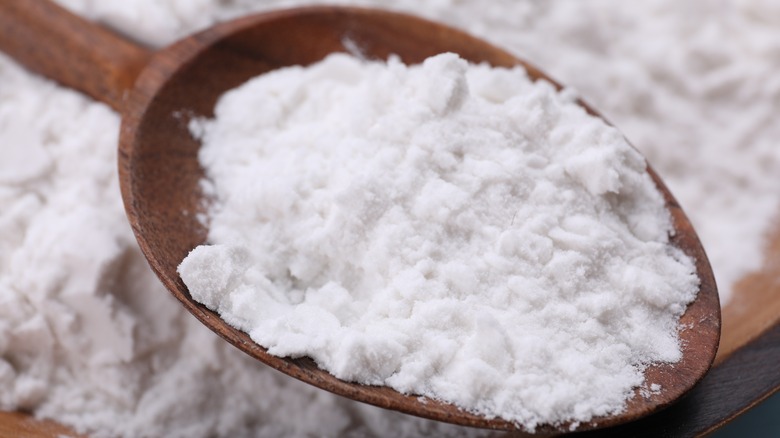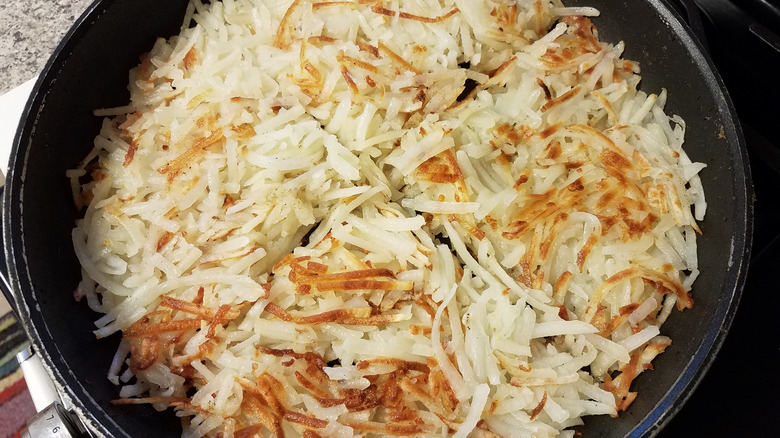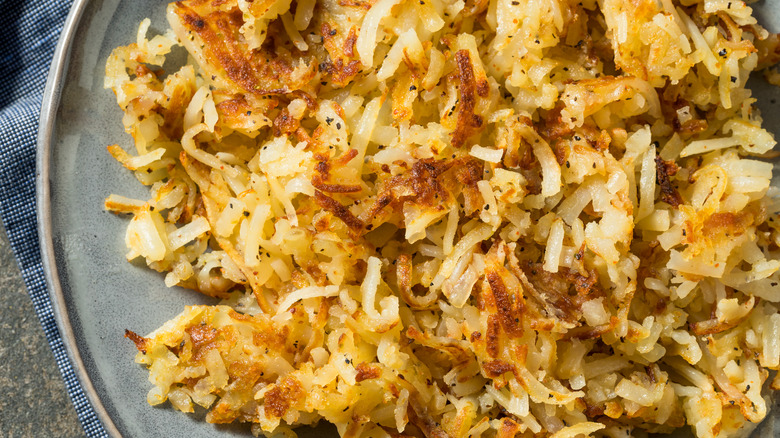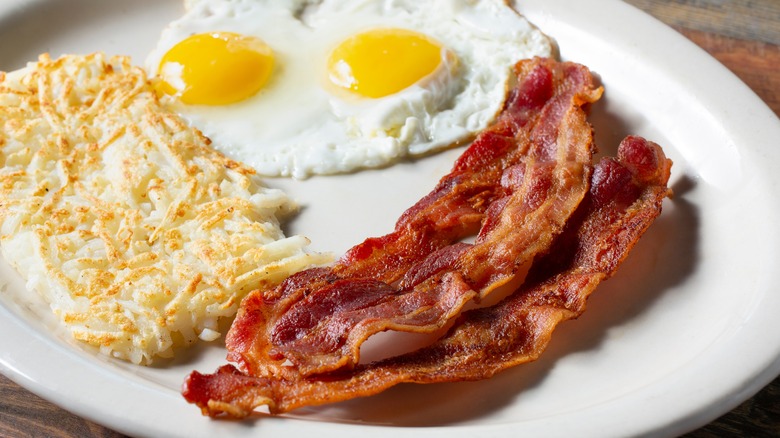Expert Reveals What Makes Restaurant Hash Browns Better Than Those You Make At Home
An order of hash browns makes everything better. They're the perfect accompaniment to a wide range of foods, with their combination of a crispy, salty, fatty exterior and a pillowy, potato-y inside offering the perfect marriage of textures. However, while you can usually rustle up a decent plate of diner-style crispy hash browns at home, there's something about the way that restaurants make them that sets them apart. Restaurant chefs know the tricks of the trade when it comes to hash browns. The specific techniques they use to prepare and cook them and the ingredients they use takes them from good to great.
However, we would argue that these techniques aren't beyond most people's reach — and the ingredients that restaurants use are widely available. You just need to know what to do, and that's where we come in. Not all restaurant chefs like to part with their hard-earned secrets, but chef Vanessa Bordoy of Nashville-based café concept Poindexter Coffee was generous enough to share her thoughts. Serving portions of smashbrowns with garlic aioli and ketchup to countless customers at Poindexter, chef Bordoy knows a thing or two about hash browns. Soon, you will too.
Restaurants choose their potatoes carefully
Because hash browns are composed solely of potatoes, you'll want to make sure that the potatoes you choose are the right ones. Unfortunately, way too many home chefs just use whichever tuber they have to hand, and don't consider their starch quantity and moisture levels. "My recommendation would be russet potatoes," says Vanessa Bordoy. "They're starchy and a bit more dry than others which is helpful to achieve the consistency and crispiness that we want." The drier the potato is, the less likely it is to steam instead of fry and develop a golden-brown crust and lacy edges.
It's worth pointing out that using russets has its own drawbacks. Because of the potato's dryness, it can hold together less effectively than other, more waxy varieties. This means that you'll need to be slightly more delicate when handling your hash browns, to ensure that they don't break apart midway through the cooking process. If you don't have any russets to hand, Yukon Golds are a good alternative. While they're less starchy than russet potatoes, they'll still make decent hash browns, and their waxiness gives them the added benefit of holding together in the pan more robustly.
Their potatoes are shredded to perfection
Your hash browns won't get far without perfectly-shredded potatoes. Getting the shredding process wrong can lead to irregularly-sized pieces which don't hold together, and ruin the texture of the dish. In restaurants that crank out multiple portions of hash browns during each service, the food processor is usually the appliance of choice. All you need to do is attach the shredding plate, and push each potato through the feeding tube at the top. Make sure you use the tamper to force them down instead of using your fingers, to avoid any risk of injury.
If you don't have a food processor, or don't want to pull the appliance out for a single portion of hash browns, just use a box grater. Shred your potato using the largest holes, again ensuring that you don't get your fingers involved. For both of these techniques, avoid the temptation to throw the leftover pieces at the end in with your mixture. While you might not think that a small lump of potato might not make any difference, having evenly-sized shredded pieces ensures that the potatoes cook at an even pace. Any irregularity will alter how they cook, and may leave you with lumps of raw potato to chew through.
Some restaurants use pre-made, dehydrated hash browns
One of the biggest secrets restaurants won't tell you is that unlike us mere mortals, their chefs don't stand around peeling and shredding potatoes all day. Instead, they buy in pre-made, dehydrated hash browns. This probably isn't a huge surprise, given that restaurants like IHOP and Denny's churn out tens of thousands of orders across the country each day. It's useful to bear in mind, though, that to perfectly replicate their hash browns, you may have to source some of these yourself.
At IHOP, the cooks rustle up their hash browns by first rehydrating them using hot water. They then throw them on a grill using a butter-flavored oil until they're perfectly crisp. They keep their seasonings pretty simple, too, and only add Castle seasoning salt to each hash brown. At Denny's, they have a similar method: Once their shredded potatoes are rehydrated, they throw them on the flat top to sizzle. Denny's chefs cook their hash browns for a surprisingly long time, with some of them cooking for up to half an hour before they're taken off and served.
In restaurants, rinsing and drying potatoes is a key step
It's not enough to simply shred your potatoes and throw them straight in the pan. For restaurant-quality hash browns, you need to add some rinsing and drying action. "We rinse and then let the shredded potato dry," says Vanessa Bordoy, about the way they make hash browns at Poindexter Coffee. "For any potato, moisture is the enemy and can cause it to become a mash (even russets)." Rinsing them allows you to remove the excess starch from the potatoes, which can cause them to cook unevenly, giving them a raw, chalky inside and an overly-crisp exterior. Drying them properly after doing this stops them from breaking down.
Doing this is super simple. You just have to pop your shredded potatoes into a bowl of water (or grate them directly into the bowl, to save time and you losing any stray pieces of potato in transit). Give them a swirl around, and then pour the potatoes into a strainer and run water through them until it's clear. Squeeze the potatoes to wring out any excess water, and then spread them out over some paper towel and pat them dry. Fluff them out slightly, and you're good to go.
Restaurant chefs choose their skillets carefully
You shouldn't just use any old skillet to cook hash browns. Restaurants certainly don't, and that's partly why theirs are so good. For the best crispiness, restaurant chefs know that cast iron skillets are the way to go. Cast iron cookware retains heat exceptionally well, and this helps crisp up the hash browns more efficiently than in a pan which dissipates heat more quickly. This also gives them a deeper, golden-brown color and more developed flavor.
Larger-scale kitchens may also use flat tops to make their hash browns. Flat tops allow chefs to make multiple hash browns in one go, and their even heat distribution ensures that each serving is uniform and crisp. Naturally, most folks don't have the capacity to put a full flat-top stove in their kitchen, but you can emulate their effect with an electric griddle — although you should be careful to avoid some key mistakes when using your griddle.
If you don't have either a cast iron skillet or an electric griddle, though, don't worry. Most pans will be able to cook hash browns perfectly well. Just make sure you're following the golden rules: Consistent heat, well-dried potatoes, and plenty of fat. You'll be just fine.
Your choice of fat is everything
The fat you use is almost as important as the potatoes you opt for. In Vanessa Bordoy's kitchen, there's only one fat that's worth using. "Always butter! Either clarified or regular butter — if you use a hot pan and a good amount of butter, you get the ideal hash brown," she says. Butter gives your hash browns a deliciously rich taste and that all-important crunch.
It's important to remember that regular butter has a fairly low smoke point, so you'll want to avoid using too high of a heat. Clarified butter, meanwhile, has a comparable smoke point to vegetable oil, and so would be our top pick to ensure that you don't give your hash browns a charred flavor. How you add the fat to your pan is also pretty important. "I always recommend adding more butter little by little after you put in the initial amount as the hash brown soaks it up and crisps," Bordoy mentions.
Don't worry if you don't have either of these fats to hand, either. "If oil is your only option, using vegetable oil will still allow you to get the heat you need for the crust on the hash brown." You can also use a combination of oil and butter, if you want to give yourself a higher smoke point but still have that moreish buttery taste.
Chefs aren't afraid of using seasoning
At their core, hash browns are delightfully simple: All you really need are potatoes and oil. However, if you want to make your hash browns restaurant-quality (and why wouldn't you?), you'll want to go big on seasonings. Hash browns need more seasoning than you might think, and unless you use enough, they'll end up frustratingly bland.
Don't make the mistake of just using salt and pepper, either. "I recommend going for classic spices like garlic powder, onion powder, dry chives, dry dill, salt, pepper, and using some cornstarch to achieve the crispy outside crust," says Vanessa Bordoy. Adding different kinds of herbs and spices into your hash browns will give you a layered, complex flavor that allows the hash browns to stand out. You don't want to over-complicate things here, so avoid adding every single seasoning you can get your hands on — but you'll be surprised at how much hash browns can take.
Additionally, avoid just sprinkling the seasonings on at the end. "Always season the shredded potato before cooking, that way the seasoning is worked in throughout the layers," Bordoy advises. Once you add your seasonings, give your potatoes a good toss, to ensure every piece is coated.
In restaurant kitchens, cornstarch is a secret ingredient
One of the biggest problems you'll face when making hash browns at home is them breaking apart. This is a common occurrence, especially when flipping them, and is more likely when following the advice here and using starchy potatoes rather than the waxy kind. That's why restaurants use cornstarch. Your potatoes "should have a thin layer of cornstarch to help bond the potato together," says Vanessa Bordoy, who recommends tossing your shreds in a little cornstarch before piling them into the pan. Doing this helps the potatoes adhere to each other, forming a pancake that stays intact more successfully.
It's vital to get the amount of cornstarch you use right, though. Bordoy points out that using too much is a common error, and doing this can lead to a chalky consistency. A good rule of thumb is to use roughly ¼ of a cup of cornstarch for every ½ pound of shredded potatoes. Make sure your cornstarch is worked through the potatoes thoroughly, to avoid any lumps of cornstarch lurking inside. You should also ensure that your potatoes are as dry as possible, so that you don't end up with a cornstarch slurry coating them.
Restaurants allow their hash browns to steam
One of the most disappointing things that can happen when cooking hash browns is flipping them out of the pan, cutting into them ... and realizing that they're still raw on the inside. In restaurants, chefs avoid this by allowing them to steam. Your pan's heat is often simply not enough to cook the hash browns right through to the middle, even if you flip them halfway through. By trapping that heat with a lid, you ensure that it penetrates to the center of the potato mound, making the inside soft and tender.
It's best to start them steaming pretty much immediately after you put them in the pan. Once they're sizzling, put a lid on the skillet, and allow them to sit for five minutes. When you take the lid off, you should notice that the bottom has turned a deep, satisfying shade of brown, while the upper layer will be noticeably softer. If you're steaming your potatoes, it's crucial that you've dried them as much as possible. If there's too much water on the potato shreds, this will cause too much steam to the pan and turn your potatoes into mash.
Don't turn your temperature up too high
In pursuit of golden-brown, perfectly crisp hash browns, it's pretty tempting to crank the heat up to high and let them sizzle. However, you should avoid that temptation as much as you can. Blasting your hash browns with heat will cause them to quickly burn, rendering your whole meal completely inedible. It's important to remember that while your potato shreds combine to make one big mound, each individual piece is very small — meaning that even a little too much heat will scorch them beyond repair.
Keep your heat moderate. "A pan or skillet at 350-365 [degrees Fahrenheit] will work perfectly to achieve that first golden layer in a hash brown," says Vanessa Bordoy. "After the flip, you can lower the temperature to 300 [degrees Fahrenheit] to ensure they're cooked all the way through." Bordoy also points out that you can transfer your hash browns to the oven after you flip them, which will help them to steadily cook and crisp up while keeping the top of the hash brown dry. If you're using this method, just make sure that your pan is ovenproof, and doesn't have any rubber or plastic components that will melt in the high heat.
In restaurants, it's all about what they serve them with
It may seem obvious, but one of the key differences between restaurant hash browns and homemade ones is what they're served with. Restaurants have access to a dizzying variety of flavor combinations, and their chefs work hard to pair this seemingly simple dish with complementary components. In Vanessa Bordoy's kitchen, garlic aioli and ketchup accompany each smashbrown to provide a deceptively complex flavor boost. Aioli's creamy tanginess works wonders with the pillowy insides of the hash brown and helps to soften the crispy exterior, while the ketchup's vinegar notes lift the simplicity of the potato flavor.
Naturally, hash browns also go well with the classics: You're more likely to find them next to some creamy scrambled eggs and bacon than you are pretty much anything else. Don't let that stop you from getting a little creative in your own kitchen, though. Guacamole, stuffed mushrooms, and even smoked cod all go well with hash browns. Whatever you're serving them with, though, just make sure you're adding the same amount of care into making it as you are into making your potatoes. Remember, a meal is only ever as good as its weakest ingredient!
